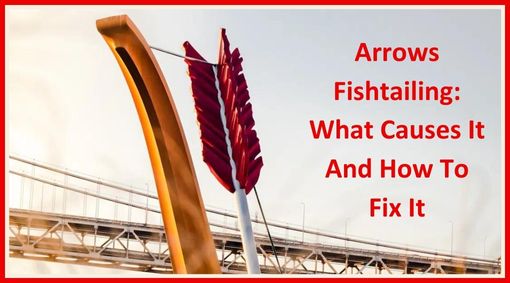Arrows fishtailing refers to the side-to-side movement or wobbling of an arrow during flight. This erratic flight pattern can cause the arrow to deviate from its intended path and result in inconsistent accuracy.
Fishtailing can manifest as the arrow oscillating left and right or as a combination of left-right and up-down movement.
The term “fishtailing” is often used interchangeably with “porpoising,” which refers to the up-and-down movement of the arrow during flight.
Both fishtailing and porpoising can be caused by similar factors, such as improper release technique, bow tuning issues, arrow spine mismatch, and inconsistent shooting form.
It is important to address fishtailing issues as they can significantly impact accuracy and consistency in archery. By identifying and addressing the underlying causes, such as adjusting release technique, tuning the bow, matching arrow spine, and improving shooting form, archers can mitigate fishtailing and achieve more consistent and accurate arrow flight.
Arrows Fishtailing: Causes and Solutions
Arrows fishtailing refers to a phenomenon in archery where arrows deviate from a straight flight path and start to oscillate or wobble in the air, resembling the movement of a fish’s tail. This can result in inconsistent accuracy and reduced precision when shooting arrows.
Improper Release
One of the most common causes of arrows fishtailing is an improper release technique. When the archer does not release the bowstring cleanly and follow through consistently, it can introduce unwanted torque or rotation to the arrow, leading to fishtailing.
Improper Release Technique:
The release technique refers to how the archer releases the bowstring. If the release is not executed correctly, it can result in the bowstring being held or torqued at the moment of release. This can cause the arrow to leave the bow with uneven forces, leading to fishtailing.
Solution
To minimize fishtailing caused by an improper release technique, it is important for archers to focus on the following aspects:
Clean Release:
The archer should aim for a clean and smooth release where the bowstring is released without any unnecessary movement or interference.
This allows the arrow to leave the bow in a straight and consistent manner.
Follow Through:
It is crucial for the archer to maintain a consistent follow-through after releasing the bowstring. This means keeping the bow hand steady and continuing the motion of the release even after the arrow has left the bow.
A proper follow-through helps to minimize any unwanted movement or rotation that can lead to fishtailing.
Consistency:
Developing a consistent release technique is essential for minimizing fishtailing. Archers should practice their release technique repeatedly to ensure that it becomes a consistent and repeatable motion.
It is recommended to seek guidance from an experienced archery coach or instructor to help identify and correct any issues with the release technique. They can provide valuable feedback and guidance to improve the release and reduce fishtailing.
Practice and repetition are key to developing a proper release technique and achieving consistent arrow flight.
Bow Tuning Issues
Another common cause of arrows fishtailing is poor bow tuning.
When a bow is not properly tuned, it can affect the arrow’s flight and lead to fishtailing. Several factors related to bow tuning can contribute to this issue:
Incorrect Arrow Spine:
The spine of an arrow refers to its stiffness. If the arrow’s spine is not matched correctly to the bow’s draw weight and draw length, it can result in fishtailing.
Using arrows with the correct spine is crucial for optimal arrow flight.
Incorrect Brace Height:
The brace height of a bow is the distance from the deepest part of the grip to the bowstring when the bow is at rest. If the brace height is set too high or too low, it can affect the arrow’s flight and cause fishtailing.
Properly adjusting the brace height is essential for minimizing this issue.
Misaligned Bow Components:
The alignment of various bow components, such as the arrow rest and the nocking point, can significantly impact arrow flight. If these components are misaligned, it can introduce inconsistencies in the arrow’s release and lead to fishtailing.
Ensuring proper alignment is crucial for mitigating this problem.
To address bow tuning issues and minimize fishtailing, it is recommended to consult with an experienced archery technician or coach. They can assist in properly matching the arrow spine to the bow, adjusting brace height, and ensuring the correct alignment of bow components. By fine-tuning these aspects of the setup, archers can improve arrow flight and reduce fishtailing.
Arrow Spine Mismatch
Arrow spine mismatch is another common cause of arrow fishtailing.
Arrows have different stiffness levels, known as spine. If the arrow’s spine is not matched correctly to the bow’s draw weight and draw length, it can affect the arrow’s flight and lead to fishtailing.
Arrow Spine:
The spine of an arrow refers to its stiffness. It is determined by the materials used and the construction of the arrow shaft. Arrows with a higher spine are stiffer, while arrows with a lower spine are more flexible.
Draw Weight and Draw Length:
The draw weight of a bow is the amount of force required to pull the bowstring back to full draw. The draw length is the distance the bowstring is pulled back before release.
Both the draw weight and draw length of the bow influence the amount of energy transferred to the arrow upon release.
Matching Arrow Spine:
It is important to match the arrow’s spine to the bow’s draw weight and draw length. If the arrow’s spine is too weak for the bow, it will flex too much upon release, resulting in fishtailing.
On the other hand, if the arrow’s spine is too stiff, it will not flex enough, also leading to fishtailing.
To avoid arrow spine mismatch and minimize fishtailing, it is recommended to consider the following:
Consulting Arrow Spine Charts:
Manufacturers often provide arrow spine charts that help match arrow spine to specific draw weights and draw lengths.
These charts can serve as a starting point for selecting the appropriate arrows.
Testing and Adjusting:
It may be necessary to test different arrows with varying spine stiffness to find the best match for your specific bow setup.
By shooting different arrows and observing their flight characteristics, you can determine which arrow spine works best for your bow.
Seeking Expert Advice:
Consulting with an experienced archery technician or coach can provide valuable guidance in selecting the correct arrow spine for your bow.
They can assess your equipment and shooting style to recommend the most appropriate arrow spine.
Matching the arrow’s spine correctly to the bow’s draw weight and draw length is crucial for achieving optimal arrow flight and minimizing fishtailing. Taking the time to ensure this match is essential for consistent and accurate shooting.
Inconsistent Form and Arrow Flight Inconsistencies
Inconsistent shooting forms, such as inconsistent anchor points or grip, can introduce inconsistencies in the arrow’s flight and result in fishtailing.
Inconsistent Anchor Points:
The anchor point is the point on your face or body where you consistently draw the bowstring back before releasing the arrow.
If your anchor point varies from shot to shot, it can affect your release and the alignment of the arrow. This misalignment can cause the arrow to fly erratically and result in fishtailing.
Inconsistent Grip:
The way you grip the bow handle can also impact the arrow’s flight.
If your grip on the bow handle varies from shot to shot, it can introduce inconsistencies in how the bow is held during the release. This can lead to variations in the arrow’s flight and contribute to fishtailing.
Other Factors:
In addition to inconsistent anchor points and grip, other aspects of shooting form, such as body posture, bow shoulder alignment, and release technique, can also impact the arrow’s flight.
Any inconsistencies in these areas can introduce variations in the release and affect the arrow’s flight path.
To address inconsistent shooting form and minimize fishtailing, consider the following:
Consistent Anchor Point:
Practice drawing the bowstring back to the same anchor point on your face or body for each shot. This will help ensure consistent alignment and release, resulting in more consistent arrow flight.
Proper Grip:
Develop a consistent and relaxed grip on the bow handle. Avoid gripping the bow too tightly, as this can introduce tension and affect the bow’s alignment during the release.
Experiment with different grip techniques to find what works best for you.
Form Check and Coaching:
Regularly evaluate your shooting form and consider seeking feedback from experienced archers or coaches.
They can help identify any inconsistencies or areas for improvement and provide guidance on proper form and technique.
Practice and Repetition:
Regular practice is crucial for developing consistent shooting form.
By repeating proper form and technique, you can train your muscle memory and improve your ability to execute consistent shots.
By addressing inconsistent form and focusing on developing a repeatable and consistent shooting technique, you can minimize the impact of form-related inconsistencies on arrow flight and reduce fishtailing.
Frequently Asked Questions
Arrow fishtailing can be a common issue in archery that can affect arrow flight. Here are some frequently asked questions about arrow fishtailing:
What is arrow fishtailing?
Arrow fishtailing refers to the erratic side-to-side movement of an arrow during flight. Instead of flying straight, the arrow may exhibit a wobbling or fish-like tail movement.
What causes arrow fishtailing?
Arrow fishtailing can be caused by various factors, including inconsistent shooting form, improper arrow spine, incorrect bow tuning, or mismatches between bow and arrow components.
How does inconsistent shooting form contribute to arrow fishtailing?
Inconsistent shooting form, such as inconsistent anchor points or grip, can introduce inconsistencies in the arrow’s flight. These inconsistencies can lead to fishtailing as the arrow is not released with consistent alignment and follow-through.
What is arrow spine, and how does it affect fishtailing?
The Arrow spine refers to the stiffness of the arrow shaft. If the arrow spine is too weak or too stiff for the bow’s draw weight and the archer’s shooting style, it can cause fishtailing. An arrow with an incorrect spine may not flex properly during the shot, leading to erratic flight.
Can bow tuning issues cause arrow fishtailing?
Yes, bow tuning issues can contribute to arrow fishtailing. Poorly tuned bows, such as misaligned arrow rest or nocking point, can affect the arrow’s flight path and result in fishtailing.
How can I fix arrow fishtailing?
Fixing arrow fishtailing involves identifying and addressing the underlying causes. This may include improving shooting form, selecting the correct arrow spine, properly tuning the bow, and ensuring all equipment components are compatible.
Should I seek professional help to address arrow fishtailing?
If you are experiencing persistent fishtailing issues that you cannot resolve on your own, it can be helpful to seek assistance from experienced archers, coaches, or bow technicians. They can provide guidance, analyze your shooting form, and help with bow tuning to address the issue effectively.

Conclusion
Remember that arrow fishtailing can have multiple causes, and it may take some trial and error to find the specific solution for your situation. Patience, practice, and seeking expert advice when needed can help you overcome arrow fishtailing and improve your overall archery performance.
Remember, addressing fishtailing may require a combination of adjustments to your technique, equipment, and setup. It may take some experimentation and practice to find the optimal solution for your specific situation.










